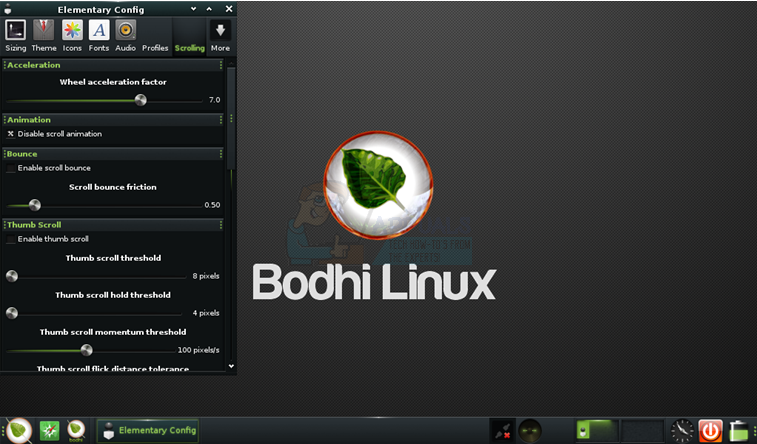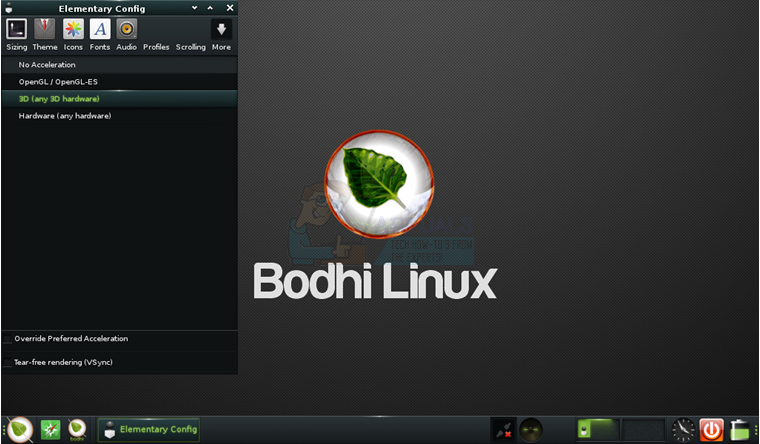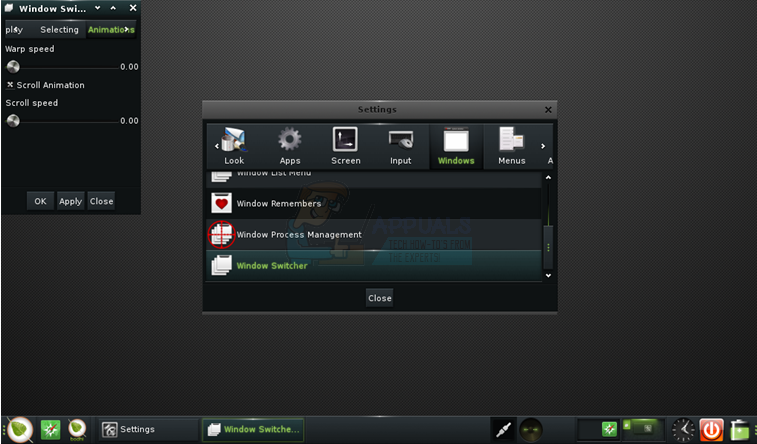While it’s possible to turn off many of these effects, people looking at the Moksha desktop more than likely would prefer to hold onto them. There are still a few tweaks that might make things work a bit more smoothly as well as make the environment behave in a way that many users expect.
Method 1: Adjusting the Scale
From the settings dialog box, open the Elementary Config window. Tap on the Sizing control to adjust the scale and Finger Size that the Moksha desktop environment uses. If you’re on an extremely small netbook or tablet computer and are having difficulty seeing things, then the scaling might be off. This is also potentially the case if you’re using Bodhi with any sort of cellular device.
Scaling is intuitive and literally scales the size of the entire desktop based around powers of two. Generally the default is sufficient.
Method 2: Changing Scrolling Functionality
From the same window, click or tap on the Scrolling button. This will provide a series of additional sliders.
Select “Disable scroll animation” for a smoother experience while ensuring that “Enable scroll bounce” and “Enable thumb scroll” are disabled. You can adjust the “Wheel acceleration factor” to make your mouse scroll wheel scroll a fewer number of lines, but this is not going to influence you much if you’re using a touschscreen or touchpad.
Method 3: Turning on Hardware Acceleration
If your Moksha environment is at all sluggish, it could be that you’re only using software drivers and not hardware drives. If you have drives installed, then tap on a top control to bring the Elementary Config window to an acceleration dialog. You may need to either tap on More and scroll down or select the control from the top if available.
It may take a bit of experimentation to get this setting correct, but if you’re currently set to No Acceleration it may be smart to either try the 3D or OpenGL/OpenGL-ES settings. Most modern graphics adapters are OpenGL-compliant.
Method 4: Changing Window Focus
Some people prefer window focus to follow the mouse pointer, as opposed to the click-to-focus system used by Microsoft Windows and OS X. From the original Settings menu, select the Window Focus control if you’d like to change this setting.
Selecting “Click Window to Focus” will mirror the behavior of Windows or OS X while “Window under the Mouse” will cause the environment to force focus on whatever window your pointer is over. This will not however raise windows unless you were to select the last option.
Method 5: Disabling Window Switcher Animation
Disabling the window switcher animation won’t be very noticeable if you were looking forward to enjoying visual effects, but it could save some strain on your GPU and CPU. From the main Settings box, click or tap the Window Switcher option. The settings present in this section will only influence the switcher gadget and no other part of the interface, which means if you have other animations turned on they won’t be effected by this at all.
Unselect the “Scroll Animation” option, and set the animation speeds to 0.00 if desired. This should have the effect of preventing these animations from playing. Click on the Apply button to test your settings and, if they’re what you want, then you should click on OK to make them stick. Should any of the settings be not to your liking, then repeat this process to undo them.
How to Load Local Flash Objects Under a Linux Desktop EnvironmentFix: Could not Find the Recovery Environment on Windows 10Nintendo of America Reportedly Involved in Promoting Toxic EnvironmentHow to Use md5sum in a Windows Command Prompt Environment




